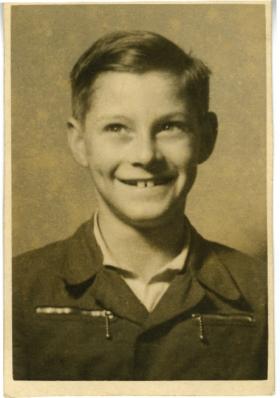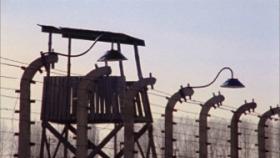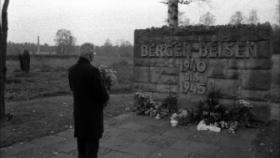TV Eye
Published in 20th-century / Contemporary History, Issue 2 (March/April 2010), Reviews, The Emergency, Volume 18I was a boy in Belsen
Praxis Pictures
18 January 2009/27 January 2010, RTÉ2
by John Gibney

Nine-year-old Tomas Reichental before he was imprisoned in Bergen-Belsen concentration camp in October 1944.
Tomas Reichental was born in Slovakia and is now an Irish citizen. He arrived in Ireland to help establish a zip factory in 1959, got married and stayed put. In his retirement, he chose to break a 55-year silence and now travels to secondary schools to tell students of experiences that still retain a capacity for pain: in October 1944, at the age of nine, he was imprisoned in Bergen-Belsen concentration camp.
While Belsen was not an extermination camp, it is worth considering the genocidal project of which it was a part. By December 1942 German forces had shot approximately 1,700,000 Jewish civilians in the occupied territories of Eastern Europe. This staggering number excludes those killed in the networks of labour and death camps: in 1942 alone, over 1,900,000 Polish Jews were killed at the dedicated extermination camps of Belzec, Sobibor and Treblinka. These figures also exclude those later exterminated in Western Europe or at the infinitely more notorious complex at Auschwitz-Birkenau, not to mention those killed by German reprisals and starvation policies directed against Jews, Slavs and the plethora of ‘minority’ groups who make up the victims of the Holocaust. Indeed, by 1943 the campaign of genocide had peaked and by June of that year the Nazi regime was already beginning to attempt to destroy the evidence of its crimes. Yet on 1 April 1943 Fianna Fáil’s unofficial organ, The Irish Press, confidently asserted that ‘there is no kind of oppression visited on any minority in Europe which the Six County nationalists have not also endured’. And three months later, on 9 July 1943, future Fine Gael stalwart Oliver J. Flanagan introduced himself to Dáil Éireann by applauding the fact that ‘there is one thing that Germany did, and that was to rout the Jews out of their country’. These statements are a matter of public record, and given that a common method of justifying embarrassing public comments is to allege that they have been taken out of context, let us pause at this point to reflect upon that context.

A watchtower at Bergen-Belsen—while it was not an extermination camp, it was part of the wider Nazi genocidal project.
By July 1943 perhaps as many as three-quarters of those killed in the Holocaust were dead. This is the incontrovertible backdrop against which Flanagan and The Irish Press uttered their statements. They stand as appalling testaments to a blinkered insularity that followed Irish independence. But Oliver J. Flanagan was not the only exponent of an explicitly Catholic anti-Semitism; it was rife in Slovakia, and this brings us back to the story of Tomas Reichental, who was old enough to remember the race laws that preceded the Holocaust. Despite this, during the war his family survived thanks to the efforts of a local priest: they were even disguised as Catholics. Eventually betrayed by locals in October 1944, they were sent to the camps. Bizarrely enough, Reichental’s father, who had been arrested earlier in the year, had met a Hungarian safebreaker on the train taking him to the camps and escaped en route, eventually becoming a partisan. The remainder of the extended family were broken up, with a group of six—including Reichental himself, his mother and his grandmother—being sent to Belsen at the behest of the notorious Alois Brunner. The rest died at Buchenwald.
This elegant film was structured around Reichental’s return to Belsen with some of his surviving relatives. In a striking moment, they gathered around an old photo, pointing out those relatives who had died and those who had survived. Reichental, imprisoned at the same time as Anne Frank, lost 35 members of his family: a brother and cousin survived. Interspersed with this were his recollections of the appalling conditions within the camps: the starvation and deprivation that were augmented by the indiscriminate sadism of the guards and the coldly murderous objectives of the camp authorities. Amidst some horrific footage was a contemporary interview with an obviously shaken British soldier who stated that, having seen the reality of the camps after their liberation, he now knew what he had been fighting for.

The adult Tomas Reichental paying tribute to his dead relatives at the Bergen-Belsen monument.
But Reichental survived. In a bizarre irony, his life between Belsen and Ireland was punctuated by both service in the Israeli Defence Forces and a stint in Germany qualifying as an engineer. He remained silent about his experiences for much of his life before being recruited by the Holocaust Education Trust; he is one of only three Holocaust survivors in Ireland. This led in turn to this excellent documentary, directed by Gerry Gregg and originally broadcast in 2009—RTÉ’s contribution to Holocaust Memorial Day. The impact of his story on some of the schoolchildren to whom he lectured was obvious, as was his own lack of bitterness. Throughout his testimony, Reichental was at pains to emphasise that the lessons to be learned from his tale were not exclusive to any one people or place: his hope was that, by relating his own experiences, he might contribute in some small way to ensuring that such things as he had witnessed could never happen again. Along the way, he provided a living link between Ireland and the experiences that defined the history of twentieth-century Europe.
There is always the possibility that Ireland’s cultural distance from World War II, as reflected in comments from both sides of its political divide, can linger in a certain cultural distance from the implications of that war. In a recent interview with the Irish Times Charlie McCreevy admitted that it was only in recent years, whilst serving as Ireland’s EU commissioner, that he became fully aware of the extent to which the legacy of the war, and the imperative to avoid any potential future conflict, was one of the fundamental driving forces of the EU. It was a disconcerting, if telling, revelation from a former minister for finance: what else did he think it was for? By telling the story of Tomas Reichental, the timely repeat of this simple but powerful documentary provided a stark reminder of the most horrendous phase of the continent’s history—a history that lies outside, but alongside, that of Ireland. HI
John Gibney was formerly an IRCHSS postdoctoral fellow at NUI Galway.
















